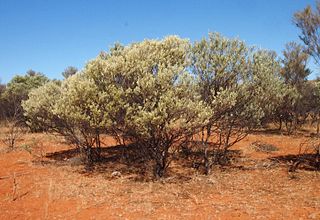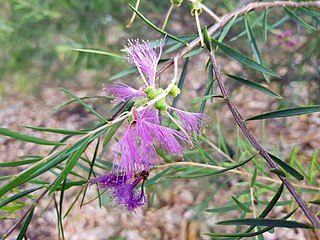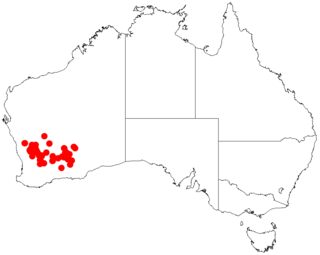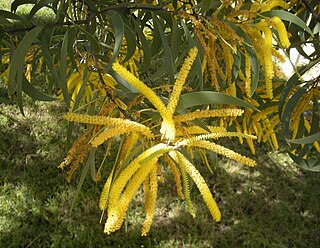
Acacia sclerosperma, commonly known as limestone wattle or silver bark wattle, is a tree in the family Fabaceae. Endemic to Western Australia, it occurs on floodplains and along water-courses throughout the arid north-west corner of the State.

Acacia terminalis is a shrub or small tree to 6 m in height. It's an Australian native whose range extends through New South Wales, Victoria and Tasmania.

Acacia cuthbertsonii is a perennial shrub or tree native to arid parts of inland and north western Australia.

Vachellia karroo, commonly known as the Sweet thorn, is a species of acacia, native to southern Africa from southern Angola east to Mozambique, and south to South Africa.

Acacia longifolia is a species of Acacia native to southeastern Australia, from the extreme southeast of Queensland, eastern New South Wales, eastern and southern Victoria, and southeastern South Australia. Common names for it include long-leaved wattle, acacia trinervis, aroma doble, golden wattle, coast wattle, sallow wattle and Sydney golden wattle. It is not listed as being a threatened species, and is considered invasive in Portugal and South Africa. In the southern region of Western Australia, it has become naturalised and has been classed as a weed by out-competing indigenous species. It is a tree that grows very quickly reaching 7–10 m in five to six years.

Acacia deanei is a tree native to Australia, which is useful for controlling soil erosion. There are two subspecies: Acacia deanei subsp. deanei and Acacia deanei subsp. paucijuga.
Henry Steedman (1866–1953) was a Scottish-born Australian botanist.
Acacia coriacea subsp. sericophylla is a shrub or tree growing 2 m to 10 m high. This subspecies of Acacia coriacea, sometimes considered a full species, is endemic to northern Australia. It flowers all year. Its flowers are light yellow to cream-colored.
Acacia acuminata subsp. acuminata is a perennial shrub or tree. Common names for it include jam and raspberry jam. It is native to Western Australia.

Acacia verticillata is a perennial shrub to small tree native to south eastern Australia.

Melaleuca fulgens, commonly known as the scarlet honey myrtle, is a plant in the myrtle family Myrtaceae, and is endemic to Western Australia, South Australia and the Northern Territory. It is notable for its showy orange, red or purple flowers, unusual foliage and fruit, and is a popular garden plant. It is a member of Melaleuca, a large and diverse genus whose members range from large trees such as M. quinquenervia, to small shrubs.

Melaleuca fulgens subsp. steedmanii, commonly known as the scarlet honey myrtle, is a plant in the myrtle family, Myrtaceae and is endemic to the south-west of Western Australia. In 1990, the species Melaleuca fulgens was separated into 3 subspecies. Of the two subspecies occurring in the south-west, this one has the narrower distribution, occurring mainly near Geraldton. As with the other subspecies, this one is notable for its showy flowers which are usually red but its foliage and fruits are also attractive features.

Acacia aemula is a shrub belonging to the genus Acacia and subgenus Alatae. It is native to an area along the south coast of Western Australia.

Acacia enervia is a shrub or tree of the genus Acacia and the subgenus Plurinerves that is endemic to an area of south western Australia.

Acacia heteroclita is a shrub or tree of the genus Acacia and the subgenus Plurinerves that is endemic to south western Australia.

Acacia inceana is a shrub or tree of the genus Acacia and the subgenus Plurinerves that is endemic to south western Australia.

Acacia pentadenia, commonly known as karri wattle, is a shrub or tree of the genus Acacia and the subgenus Pulchellae.

Acacia macdonnelliensis, commonly known as the MacDonnell mulga or the Hill mulga, is a species of Acacia native to central Australia. The Indigenous Australians the Alyawarr peoples know the plant as irrar, the Kaytetye know it as arleth-arlethe or arwele arleth-arlethe and the Western Arrernte peoples know it as irrkwarteke.

Acacia crassa, commonly known as the curracabah, is a species of Acacia native to eastern Australia.
















